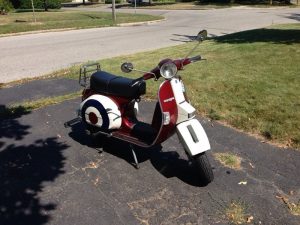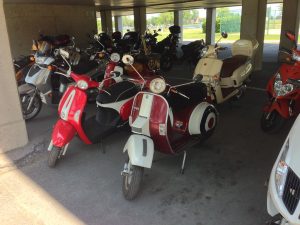(Editor’s note: Past Due Reviews are special articles giving reviews of machines that are not current, are occasionally well used, and well past the due date for a newly arrived machine. They’re intended to give a second chance to classic, unusual, or indeed any scooter has a story that needs to be told. We hope you enjoy.)

There is something about a shifty Vespa that cannot be replicated by a modern twist and go scooter.
It might be the way it is a factory of sensation, from the noise it makes to the physical sensation of twisting the grip and feeling the scooter thunk into gear. The smells, the way the eye follows the curve – all of these combine to let you know why these machines became the poster child of the scooter crowd, the very emblem of what someone would draw if asked to draw a scooter.
I’ve had several P series Vespas over the years – ranging from PX125E Arcobalenos to a P200 that had a bit of a mechanical curse – and they’ve all been machines that seemed more character than creation of an assembly line.
The P Series Vespas were the last of the manual shift Vespas and shared much in common with their earlier (though curvier in design) cousins. Tires were 10 inch, up from the 8 inch of most earlier models. Engines came in either a 125cc, 150cc or 200cc size.
They retained the twist grip manual clutch and shifter of earlier Vespas, but despite some of the mechanical similarities they are often seen as being more angular than earlier Vespas, and are seen to lack some of the visual charms of the earlier models. (Though often the engines are sought after for earlier models as mechanical upgrades, especially the P200 engine which along with the Rally 200 was the largest manual shift engine produced by Piaggio.)
My own Vespa ownership started with a project bike purchased as an upgrade to a Honda Jazz 50cc. I was starting to venture out of the city more, and had just (finally) taken a motorcycle course and learned how to operate a clutch and manual shifter after years of riding a 50cc machine on a learners permit.
I purchased my PX125E as a project, an Italian export that had been ridden for most of its’ life in a warmer climate and (judging from the bodywork) regularly subjected to random sledgehammer attacks which could only be abated by apparently running into a wall. It had lived a hard life and was hardly the smooth shining style in motion machine it had been born as.
I’m sure I didn’t do it any favours either – my clutch technique still being somewhat iffy and the resulting gear changes were a combination of lurching and grinding in roughly equal proportions.
Still, the ancient beast was a revelation coming off of a 50cc 4 stroke scooter – it accelerated at (what I thought of at the time at least) a breakneck pace, and reached a top speed of roughly 80kph. Compared to the maximum of 60kph my former machine had reached…. on the flat….. with a tailwind…. and some luck…. this was race track territory. I was pretty sure if I went to this unreal top speed I’d probably rip my face entirely off.
So what was it like, owning a P-series Vespa?
The Good:
- Italian style! There is something about a Vespa, even the less-loved P series, that just stands out. Most people forced to draw a scooter would draw something resembling a vintage Vespa, and there is a reason it still symbolizes scootering to me.
- More Power! Reasonably zippy for a 125cc.
- Tough. The steel bodied P series could take knocks and bangs and keep on going They’ve entered into the Dakar rally, they were the backbone of the Italian postal service for years.
- Simple to maintain. A P series engine can be dropped out of the body with basically one large bolt removed, then can be run outside of the body. While a complete engine rebuild still requires specialized equipment and skills, simple things like replacing a throttle cable or fixing a plugged carburetor can be done with limited tools and skills. Tires can be replaced with basic tools, and much of the service is far easier than on other bikes.
- Produced still – the PX150 is till produced in some markets and parts are still available. There is a large variety of aftermarket and performance parts available from a variety of vendors.
The Bad:
- Two stroke – while some love 2 smoke engines, they do pollute more and require oil to be added to the gasoline. They can seize if improperly jetted or if the oil runs out or isn’t properly mixed with the oil, and after a while you can feel a bit like a smoked kipper. Except less appetizing.
- Two stroke temperment – the bike will perform a little differently based on weather, temperature, and the mood of the motor. Don’t make the lump angry.
- Unbalanced engine – the P series motor is not symmetrical over the rear tire and this causes some interesting things to happen during braking in the wet, namely that your read end will tend to slide and come around if the brakes lock up. And if you have an earlier P series your drum brakes *will* tend to lock in the wet, requiring you to very gently tap them to warm them up before they will work properly.
Conclusion:
If you love a clutch, love Vespa style, love anything vintage and all steel – then the P series Vespa may be for you. While it may not have the style of the earlier models, and it may not have the convenience of a twist and go modern scooter, it has a combination of simple technology and vintage style while keeping a reasonable price point on the used market.
Keep in mind that while the P series will be more reliable than some earlier models and parts are easy to come by this is still a vintage styled machine and will require more upkeep and general mechanical awareness than a more modern scooter.
Still — I’d compare them to an original Mini for automotive gearheads – they are almost a rite of passage any major scooterist will go through. And you might curse their quirks, get dirty fixing on the side of the road, or get tired of constantly looking like you’ve been servicing a Victorian steam engine after a ride…. but once you’ve had one of these beasts you will never let go of a certain fondness for them.
There is just something about a manual shift, Italian style, and two stroke smoke. And once you know what that something is, it never lets you entirely go.


Still riding my Puch DS60 … and love kippers.